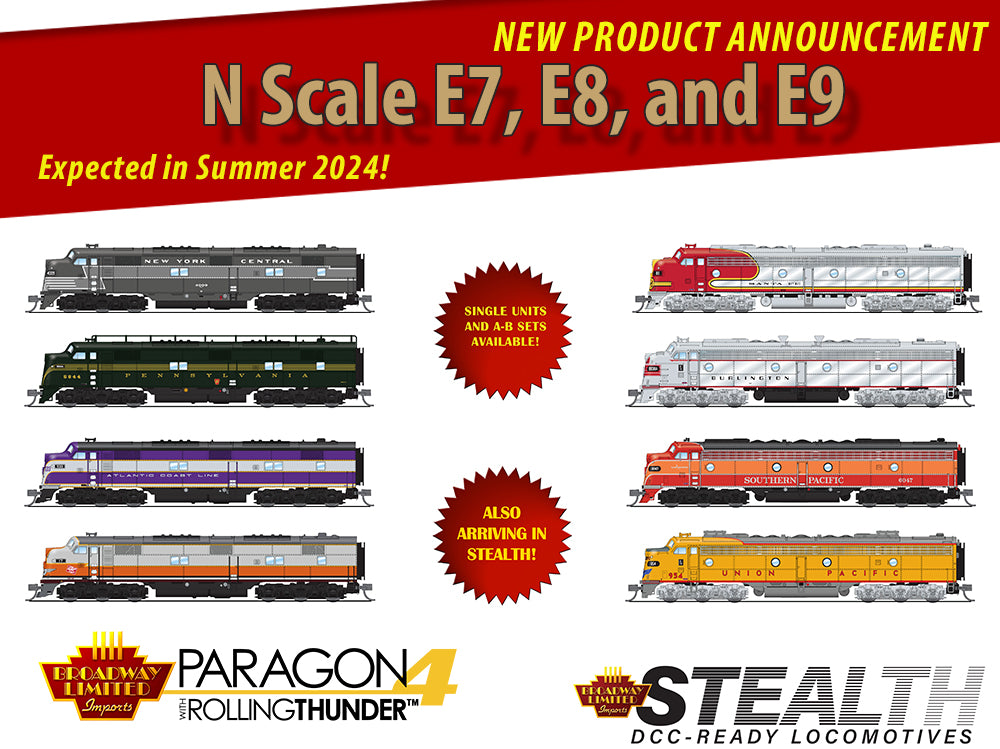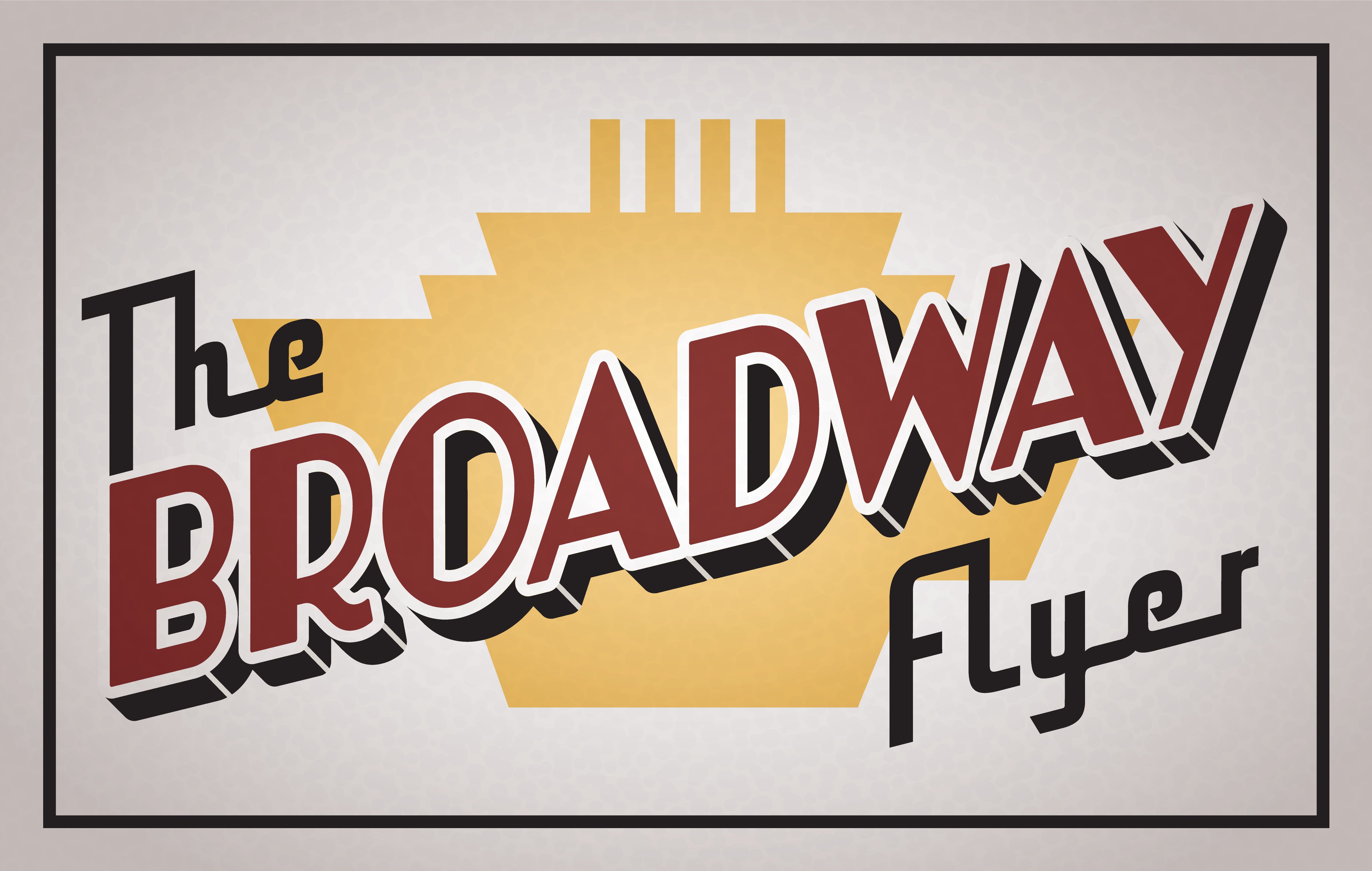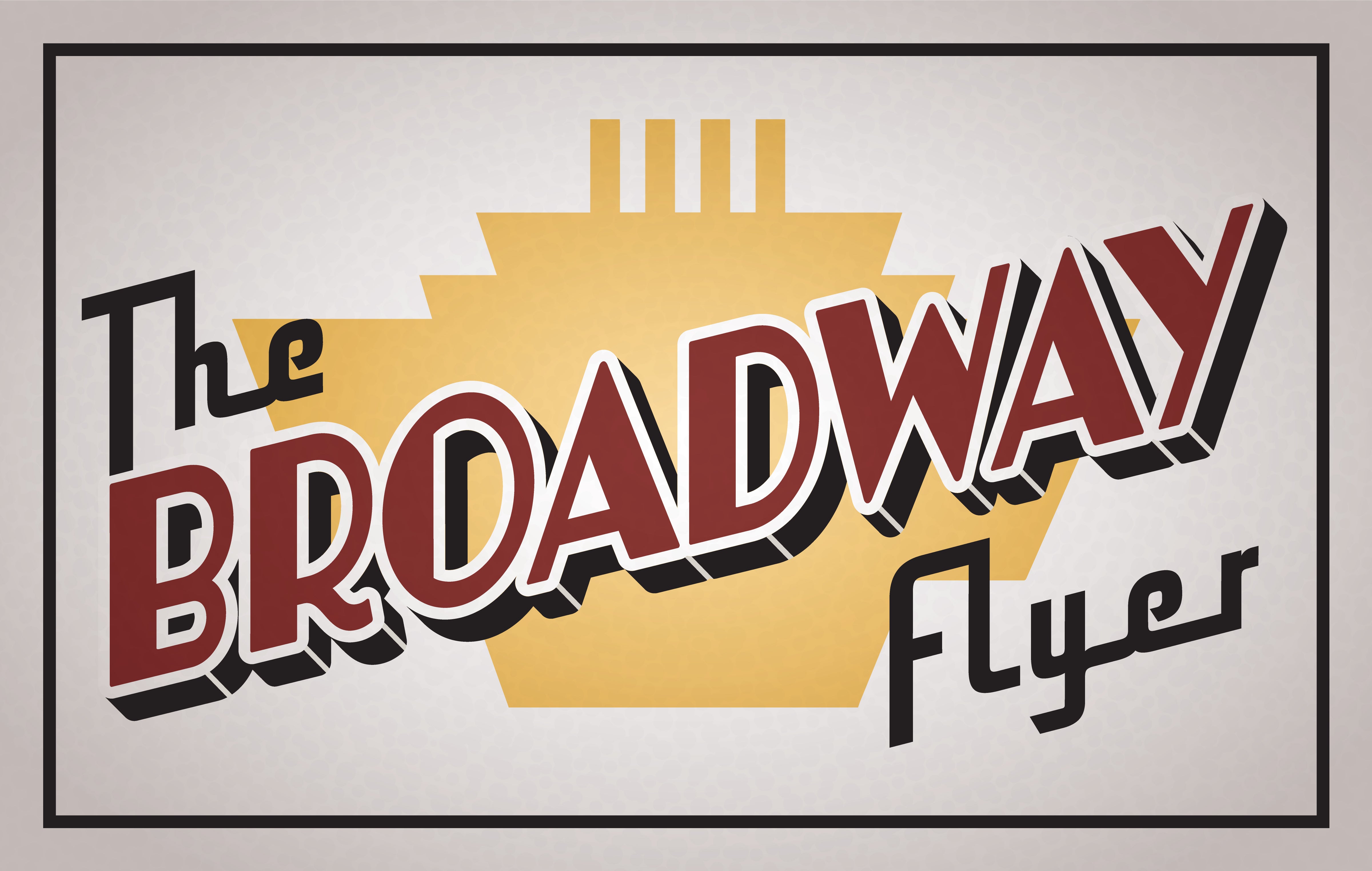
NEW PRODUCT ANNOUNCEMENT: N Scale E7 and N Scale E8/E9
We here at Broadway Limited Imports are proud to introduce two newly tooled N Scale diesels to market in 2024. These E7's, E8's and E9's are all NEW tooling with road specific details based on the prototype. We haven't made these classic locomotives in quite some time, so we are extremely excited to bring these back, especially in our revolutionary Paragon4 sound system and make them better than ever!
The order deadline for these locomotives is November 30th, 2023. With an expected arrival for Summer of 2024.
















The E7A featured a less slanted front nose compared to earlier EMD passenger locomotives, earning it and its successors, the E8 and E9, the nickname 'bulldog nose' units. Some of the earlier units were referred to as 'shovel nose' or 'slant nose' units. More than 20 different railroads acquired E7s for their passenger trains. Currently, only one E7 example survives, with ex-Pennsylvania Railroad E7A #5901 being preserved, cosmetically restored, and on display at the Railroad Museum of Pennsylvania in Strasburg, Pennsylvania.
In this production, we are modeling A and B-units from 6 railroads with prototypically accurate road numbers and paint schemes. We are offering A-B sets with Powered A-units (w/ Paragon4 Sound) and unpowered B-units, and also separate single A and B-units (where appropriate) with our full Paragon4 DC/DCC/Sound system. All of our models have road-specific details and lighting.
Road-specific detail options in this production, prototypically accurate for each road name:
- Pilot prototypical for paint scheme
- Operating Mars Light where prototypical
- Small horizontal and Large 45-degree numberboards
- Prototypical horn
- Water fill hatch location
- Sand fill hatch location
- Dynamic brake where prototypical
- Cooling fans and exhaust hatch accurate per each prototype
- Winterization hatch present where prototypically accurate
- Multiple MU door options on front of model
- Multiple skirt options above fuel tank
- Ladder rest grab irons present where prototypically accurate
- Grab iron ladder present where prototypically accurate
- Eyebrow grab irons present where prototypically accurate
- Grab irons above cab side windows where prototypically accurate
- Roof antenna present and correct where prototypically accurate
- Front and Rear lift lug present where accurate
- Nose door number plate present where accurate
- Trainphone antenna present where accurate
- Paragon4 Sound & Control System featuring ROLLING THUNDER
- Integral Dual-Mode Decoder with Back EMF for Superb Slow Speed Operation in DC and DCC
- Precision Drive Mechanism Engineered for Heavy Towing and Smooth Slow Speed Operation
- All Wheel Electrical Pick-up
- ABS Body with Die Cast Chassis for Maximum Tractive Effort
- Premium Caliber Painting
- Prototypically Accurate Paint Schemes and Road Numbers
- Many Separately Applied Details such as Grab Irons, Horns, and Bell
- Prototypical Light Operation
- Prototypically Accurate Sounds for the EMD E7 Diesel Locomotive
- MicroTrains-compatible Couplers (2)
- Will Operate on Code 55, Code 70 and Code 80 Rail
- Minimum Operating Radius: 9 inches
Next up we have the E8's and E9's! Before we go into the details of the locomotives, let's show you the many paint schemes we are making in this production run.













Following the success of the EMD E7, the E8 and E9 locomotives gained equal popularity among many Class 1 railroads. The E8 and E9 marked the culmination of the "E-Unit" series of passenger locomotives produced by General Motors' Electro-Motive Division in La Grange, Illinois. The E8 was capable of producing 2,250 horsepower, thanks to its two 12-cylinder model 567B engines, each driving a generator to power the two traction motors on one truck. From August 1949 to January 1954, a total of 450 cab versions, or E8As, were manufactured, with 447 for the U.S. and 3 for Canada. Additionally, 46 E8Bs were built exclusively for the U.S. from December 1949 to January 1954.
The E9 followed the success of the E8. These locomotives produced slightly more horsepower than their predecessors, the E8s (2,400 compared to 2,250), and featured a different, flusher-fitting mounting for the headlight glass as the only visible difference. E9s powered American passenger and mail trains from the 1950s through the late 1970s. E9s were frequently seen pulling some of America's most iconic trains, including Union Pacific Railroad's "City" fleet, Burlington's "Zephyr" fleet, and Southern Pacific Railroad's Coast Daylight and Sunset Limited. Between April 1954 and January 1964, 100 cab-equipped A units and 44 cabless booster B units were produced, all for service in the United States.
E9s, along with their E7 and E8 predecessors, traversed the country on lesser-known passenger trains, Chicago's commuter train network, and various mail and express trains. As America's passenger train network diminished due to declining ridership, Union Pacific, Rock Island, and Illinois Central repurposed E9s for freight trains. Burlington Northern and Chicago and North Western upgraded their fleets of E9s with Head-end power and EMD 645 power assemblies for commuter operations in the Chicago metropolitan area, a practice that continued into the early 1990s.
Numerous examples of E8s and E9s are preserved across the country. Many are still operational at museums and tourist railroads nationwide. Union Pacific, in particular, maintains a fleet of three E9s, occasionally deploying them for excursion services or for transporting railroad executives across the Union Pacific system.
In this production, we are modeling A and B-units from 8 railroads with prototypically accurate road numbers and paint schemes. We are offering A-B sets with Powered A-units (w/ Paragon4 Sound) and unpowered B-units, and also separate single A and B-units (where appropriate) with our full Paragon4 DC/DCC/Sound system. All of our models have road-specific details and lighting.
- Pilot prototypical for paint scheme
- Operating Mars Light where prototypical
- Small horizontal and Large 45-degree numberboards
- Prototypical horn
- Water fill hatch location
- Sand fill hatch location
- Dynamic brake where prototypical
- Cooling fans and exhaust hatch accurate per each prototype
- Winterization hatch present where prototypically accurate
- Multiple MU door options on front of model
- Multiple skirt options above fuel tank
- Ladder rest grab irons present where prototypically accurate
- Grab iron ladder present where prototypically accurate
- Eyebrow grab irons present where prototypically accurate
- Grab irons above cab side windows where prototypically accurate
- Roof antenna present and correct where prototypically accurate
- Front and Rear lift lug present where accurate
- Nose door number plate present where accurate
- Trainphone antenna present where accurate
- Paragon4 Sound & Control System featuring ROLLING THUNDER
- Integral Dual-Mode Decoder with Back EMF for Superb Slow Speed Operation in DC and DCC
- Precision Drive Mechanism Engineered for Heavy Towing and Smooth Slow Speed Operation
- All Wheel Electrical Pick-up
- ABS Body with Die Cast Chassis for Maximum Tractive Effort
- Premium Caliber Painting
- Prototypically Accurate Paint Schemes and Road Numbers
- Many Separately Applied Details such as Grab Irons, Horns, and Bell
- Prototypical Light Operation
- Prototypically Accurate Sounds for the EMD E8/E9 Diesel Locomotive
- MicroTrains-compatible Couplers (2)
- Will Operate on Code 55, Code 70 and Code 80 Rail
- Minimum Operating Radius: 9 inches



12 comments
I’d also like to see the I.C. represented when you can. They are certainly hard to find these days!
Eric Frazier
PLEASE tell me you will be producing these in Illinois Central chocolate/orange!
Gary Wygal
Will you be producing in any other road names, such as Canadian Pacific or any others?
Kevin P Heatherly
The SP&S is worth the weight.
Ken Giles
The SP&S is worth the weight.
Ken Giles
Fantastic, however, you forgot the Canadian Pacific’s E-8’s. Would have been nice to see the Maroon and Grey Beaver scheme offered.
Vince Crysler
These are nice but… I am REALLY disappointed that you are not modeling the Illinois Central in chocolate/orange from the late 50’s to early 60’s. I’ve been looking everywhere to buy your earlier units from a few years ago with no success, and was hoping you might reconsider this famous road.
Anonymous
Would love to know which units have Mars lights
Thomas
WOOOOOOOOOOO. NEW ACL E UNITS!!!!!!!!
Zeus Hernandez
WOOOOOOOOOOO. NEW ACL E UNITS!!!!!!!!
Zeus Hernandez
First, more questions. Which of the paint schemes shown under E8/E9 represent “real world” E8s and which E9s? Will the undecorated models include all the parts that vary between the decorated units according to their prototypes, such as the pilots? Now some comments: I do like many of the paint schemes BLI is doing. The B&O, MEC, NYC and PRR liveries are, I think, the best looking ones those roads used. The B&M’s “Rock Island” E7 paint scheme, intended to match its newest passenger cars that had a lot of stainless, didn’t look good with older head end cars and coaches and the roof showed dirt; it didn’t last long before being replaced by the maroon version of the livery BLI shows for the MEC.
Stephen T. Wagner
I’m in HO scale but will be writing about the northeastern US paint schemes (B&M, B&O, C&O, MEC, NYC, PRR) for the November Bridge Line Historical Society Bulletin, with a deadline for submissions at noon on Friday, Sept. 22. A listing of the road numbers for each paint scheme would be good to have. Also the list prices and ETA.
Stephen T. Wagner
Leave a comment
This site is protected by hCaptcha and the hCaptcha Privacy Policy and Terms of Service apply.